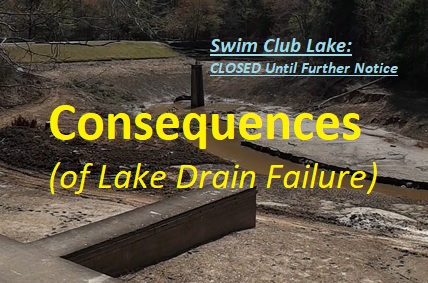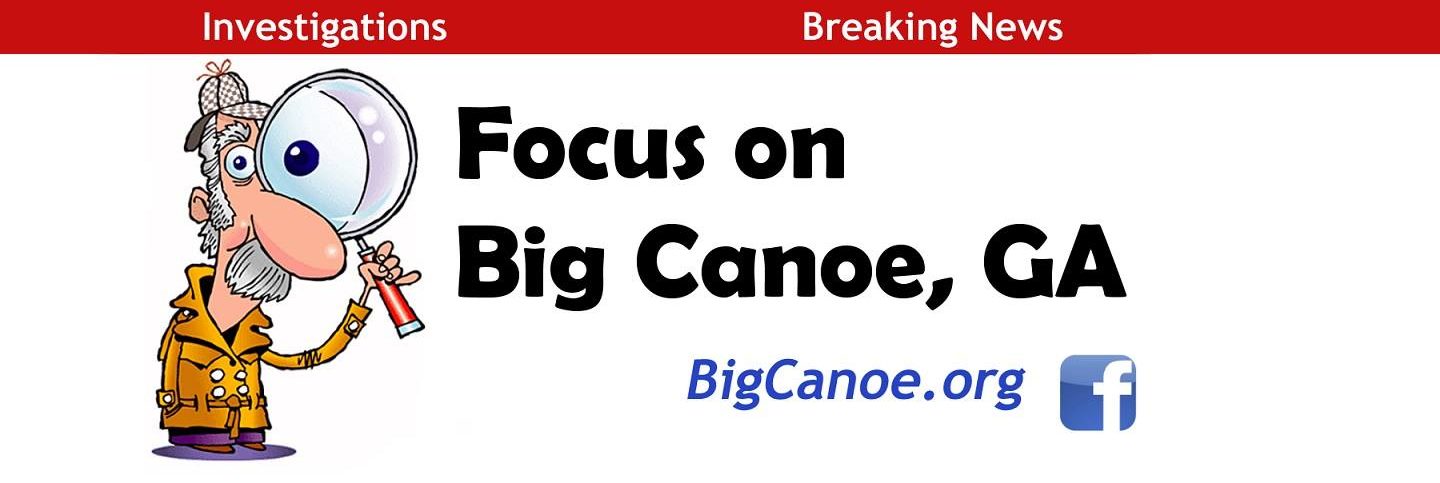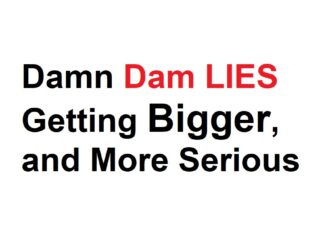
This is the 6th Installment on our Series about Lake Petit Dam. Another independent community writer, Patricia Cross, also has a good article on the financial aspect of all this. All property owners should be on her mailing list if they aren’t already. She does good financial analysis on a multitude of Big Canoe issues.
This story is NOT about the currently empty and drained Big Canoe Swim Club Lake, Lake Disharoon, which is pictured above – but the timing of this event makes it the perfect lead-in to our story, which is still about the Lake Petit Dam.
The above picture shows Lake Disharoon drained dry so that a repair could be made to the Lake Drain “GATE”. Do you see that Tower in the middle of the lakebed? At the top is a wheel that raises and lowers a “Gate” at the bottom of that tower. Opening that “Gate” lets water drain out through the “Lower Lake Drain Pipe”. There was a problem with the “Gate”, so they had to drain the lake to get down to fix it. When they opened that “Gate”, water poured through that “Lower lake Drain Pipe” at high pressure. During that process, the engineers realized that they had a “a problem between the inlet structure and the outlet’s pipeline”, which is another way to say the “Lower Lake Drain Pipe”, which runs through the entire bottom width of the earthen dam. Here is a pictorial representation to give an idea of the scope of what is involved.
Before we move on I want to leave readers with a question. If all the water in the relatively small Disharoon Lake had to be drained so that workers could get to the “Gate” which is at the bottom of the 10 ft lake, then what will have to be done with all the 35 – 40 feet of earth and rock in the Lake Disharoon Dam that sits above the “Lower Lake Drain Pipe” that runs underneath the entire width of the Disharoon Dam, if that pipe needs fixing?
And a reminder…. that any repairs to the Lake Petit “Lower Lake Drain Pipe” or “Gate” will require the same approach, but involves a “Gate” that is located under 96 ft of water that has to be drained, and a “Lower Lake Drain Pipe” that is located under approximately 125 ft of earth and rock that has to be removed, and then the Dam rebuilt to current design standards, not those that existed in 1972. I am told that when they drained and rebuilt Grandview Lake, the Stability factors required were much higher than previously existed. $$$ Also a reminder that Big Canoe’s 5 Year Master Plan, which they did NOT run by Ga Safe Dams, and that Safe Dams has not approved, only allocated a trivial $1.5 Million to this issue., nor did they acknowledge that the entire lake will have to be drained.
“GATE” & “LOWER LAKE DRAIN PIPE” ISSUES IN LAKE PETIT DAM
The specific problem with the Lake Petit system is that it has NEVER been tested in the 50 year existence of the Dam, yet there is a legal requirement that it be tested each and every year, and that Big Canoe has run out of excuses. In 2005 Big Canoe was directly told to open and test the system, but Big Canoe did a Dive Inspection, and reported to Ga Safe Dams that the Grate was “buried in four to six feet of silt”, and that draining Lake Petit jeopardized “the drinking water for the entire community”. Well, Lake Petit no longer supplies the drinking water for the community, and in the recent 2020 Dive Inspection, it was reported that Divers found that there was only “one foot of mud and sticks around the sluice gate which was removed by the diver”. So the Gate is clear, and there are no longer water supply excuses. After 50 years, Ga Safe Dams will now feel comfortable enforcing the regulatory requirement that the Gate and Drain System be tested every year, beginning soon with an initial test, which they have begun to prepare the compliance requirements for.
Internal Safe Dams Compliance Email
Opening the Sluice Gate for the first time ever does carry the risk that it gets stuck, and the lake is rapidly drained. That poses another risk, that the shoreline around the lake could collapse, possibly dragging houses down. In preparation for a Gate test, Ga Safe Dams seems to be preparing a Compliance Act that would require Big Canoe to lower Lake Petit 32 ft – 48 ft. prior to running the test. This would involve slowly and safely draining down the lake to approximately 35 – 50%, in a manner that reduces shoreline collapse. An email dated October 6, 2020, which was interestingly written just after the 2020 Dive Inspection, specifically uses Lake Petit as an example, and Safe Dams Director Tom Woosley writes,
“Lake Petit at 125 foot tall the 1/3 would be 32 feet.” ….. “The program staff will use 1/3 of the water depth as a starting point for lake level lowering.” ….. “If a cap then perhaps no more than 1/2 water depth but again allowing engineering judgment in case condition of dam warrants more.”
It appears that Ga Safe Dams is possibly preparing its path for what is a very difficult situation – enforcing regulatory compliance in testing the Lower Lake Drain Gate & Pipe System, while walking safety tightropes. I believe that this will be a two stage process (1) Lower the Lake Levels 35 – 50% to stabilize the shorelines slowly (2) Open the Lake Drain Gate for testing, and cross your fingers that the pipes hold. It was at this stage that they have just found internal piping issues with Lake Disharoon.
Thought Exercise: Where will the property owner boats be stored when the lake is drained down that far, and who will pay for them to be moved?
ILLEGAL MANAGEMENT PRACTICES
There are not only strict legal requirements that annual checks of the Gate and Drainage systems be performed, but also that it be legally verified. Here is an excerpt from the Georgia Code:
From the “Rules and Regulations of the State of Georgia”, Safe Dams Rule 391-3-8-.10 Inspection and Maintenance Plan Requirements
(1) (c) Insure that all gates, orifices, dissipators, trash racks, and other appurtenances that affect the proper operation of the dam and reservoir are kept in good repair and working order, and that spillway and outlet gates necessary to pass flood flows shall be test operated at least once each year. The dam owner shall file an affidavit with the Director certifying that such gates and other appurtenances are in good repair and working order
This Newspaper was curious to see if Big Canoe had been complying with their legal certification requirements, and filed an Open Records Request seeking copies of filed Affidavits. An April 8, 2020 Records Response was received in the form of an email, which stated in part,
“After further investigation the Watershed Protection Branch does not have any records related to this portion of your request. Additionally, the Safe Dams Unit has not received an affidavit..”
Big Canoe is not only NOT COMPLYING with the actual inspection and maintenance requirements, they are wantonly disregarding their certification requirements. Both of these leave easily ascertainable legal trails that may have additional consequences.
INSURANCE RAMIFICATIONS
Big Canoe’s March 22, 2021 POA Board Minutes have a section that is clearly in relation to issues regarding the Dam, and which is excerpted as follows:
Insurance: Scott is still waiting for clarification from broker regarding Flood portion of the Flood & Quake coverage increase in order to make a decision.
At last check, Marsh McClellan is Big Canoe’s policy provider. My guess is that like most Insurers, they have some very tight policy language which mandates regulatory requirements, standards of care, etc. In my experience, those can constitute loopholes for non-payment of claim if not followed. So here are some very simple question for the Big Canoe Management and POA Board Teams:
1) Does our Insurance Provider know that Big Canoe is not effectively in compliance?
2) Do they know Big Canoe isn’t filing legally required Affidavits?
3) Is there language in the Policy that could be used to justify non-payment of claim in the event of a catastrophe, and in which it can be proved that Big Canoe was not in regulatory compliance?
4) Has the POA Attorney reviewed the Policy in regards to #3?
5) Has the POA Attorney reviewed the level of compliance the Dam was under when the Big Canoe Developer transferred the Dam to the POA? Just saying…. there are some interesting documents out there in the records. Here are just three from the 1979 / 1980 timeframe. (A) 1979 Deficiencies Ltr to Governor; also a (B) 1980 Ltr to Dam Design Engineer Cranston Baldwin Assoc requesting Stability Re-Anaysis; and another (C) 1980 Ltr to the Big Canoe Developer requiring a detailed Engineering Report on corrective measures. I can find no subsequent engineering justifications as were requested. Was this ever done, or was the POA deeded a Dam that was in non-compliance, and that had a non-compliant design?
Don’t forget (D) Big Canoe Developer Engineer Tom Robertson’s 1997 Phone Log, where it was noted that, “he was concerned about operating the low level gate valve and it jamming open …. It has never been opened to his knowledge.”
6) Have individual Board Members, and Management Team Members undertaken legal review of their own personal liabilities for being a part of the ongoing non-compliance?
I believe Property Owners deserve an answer to at least the 1st five of those questions.
LEGAL RAMIFICATIONS
There are a multitude of legal resources available online that point to the importance of following regulatory compliance, and the subsequent risk of increased liability for not complying. The National Dam Safety website has an entire section on the subject, which included an old, but widely referenced 48 page legal study on the subject, which was quite comprehensive regarding the legal theories involved.
The bottom line is that the entire financial stability of the broader Big Canoe Community is being jeopardized by the irresponsible and illegal practices of its Board and Management teams. In the event of something serious happening, Big Canoe will be buried under legal claims, and due to an easily provable history of wanton disregard for our regulatory responsibilities, will most likely not have a legal leg to stand on in defense.
ATTORNEY & SAFE DAMS COMMUNICATIONS REVEAL DISTURBING FACTS
Back in February this Newspaper filed another Open Records Request, more of which is still yet to be released. One of those documents was a Feb 24 Phone Log between Safe Dams Director Tom Woosley, and an “Attorney representing several residents of Big Canoe”. An excerpt from that redacted document is a statement from Director Woosley as follows:
“…the only issue at the dam has to do with the low level drain valve and its operability.”
This is an incredibly important statement, because it was made just a few days before Big Canoe’s “Virtual Cheerleader” Town Hall, in which they introduced the Lake Petit Dam “5 Year Master Plan”….. a plan which focused most heavily on Spillway replacement, and makes no mention of having to completely drain the lake, or dig up the entire Dam, and really glosses over any real discussion of the issues with the “low level drain valve”.
Fast forward to the end of March, and this Newspaper put in yet another Open Records Request (March 31). One of the documents received in response was a March 24, 2021 Phone Log between Safe Dams and our Engineer, Geosyntec. In that Phone Log, Geosyntec Engineer McDonald stated the following:
They are in the process of doing a full Hydrology and Hydraulics (H&H) study on the dam, and that spillway modification may be needed. He also indicated that low-level drain improvements were probably needed.
They already had all the Dive and Camera Inspection Reports for months (even though they have still not given them to Safe Dams as of April 6). How did they go from a primary, public project level focus on a “may be needed” Spillway, to behind the scenes “probably needed” low-level drain improvement.
* Disclaimer: Much of the money presented as allocated for the ” lower lake drain”is only for alternative pumping equipment to lower the lake, so that they can get to the point that they can actually test the “Gate” and the “Lower Level Drain Pipe”, but there is no rational money allocated for the actual scenario in which the test fails, or serious Pipe/Gate repairs are needed. Remember, we are opening the lower lake drain gate for the first time EVER in its 50 year existence. What could possibly go wrong?
Which brings us full circle back to the beginning of this article, as we remember that the problems in the low level drain pipes in Lake Disharoon Dam weren’t expected either, even though it should have been easy to predict considering the fact that all of these Dams are hitting their 50 year life expectancy.
As Big Canoe’s Cheerleader-In-Chief, Scott Auer, recently put it in the POA’s April 7 eblast distribution about Lake Disharoon…
“…the situation is a reminder that much of Big Canoe is nearly a half-century old, meaning routine and often unforeseen repairs are the norm and not the exception.”
It is a shame that the past due bill for decades of delayed maintenance is about to be dumped unceremoniously on current property owners, including a crop of 400+/- new property owners who had no prior disclosure of the infrastructure problems rampant in Big Canoe.
Peace,
– david / publisher
Focus on Big Canoe, GA
* a publication of The Mountains Voice
Concerned Citizens are encouraged to write the Governor to demand oversite of this Lake Petit Dam situation. I believe that Safe Dams Director Tom Woosley bears the blame for allowing this situation to evolve to the point that it has, and indeed has been at the helm of the Safe Dams Program during a time that it has received the LOWEST Grades on Georgia’s Infrastructure Report Card. The Governor needs to step in.
Georgia Governor Brian Kemp
Office of the Governor
206 Washington Street
111 State Capitol
Atlanta, GA 30334
(404)656-1776
georgia.governor@gov.state.ga.us
cc: Governor Top Staff
caylee.noggle@georgia.gov, bert.brantley@georgia.gov, lauren.curry@georgia.gov, cody.hall@georgia.gov, tate.mitchell@georgia.gov,
cc: EPD Top Staff
askEPD@gaepd.org, james.capp@dnr.ga.gov, anna.truszczynski@dnr.ga.gov, arnettia.murphy@dnr.ga.gov, lewis.hays@dnr.ga.gov, jennifer.welte@dnr.ga.gov, tom.woosley@dnr.ga.gov, james.cooley@dnr.ga.gov, john.maddox@dnr.ga.gov




Be the first to comment